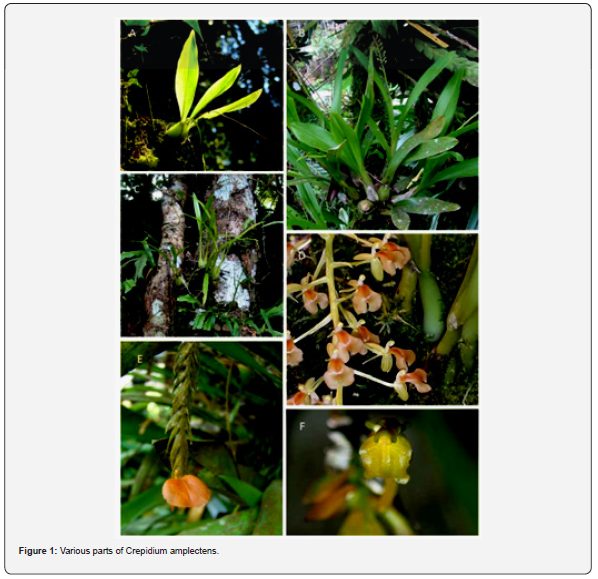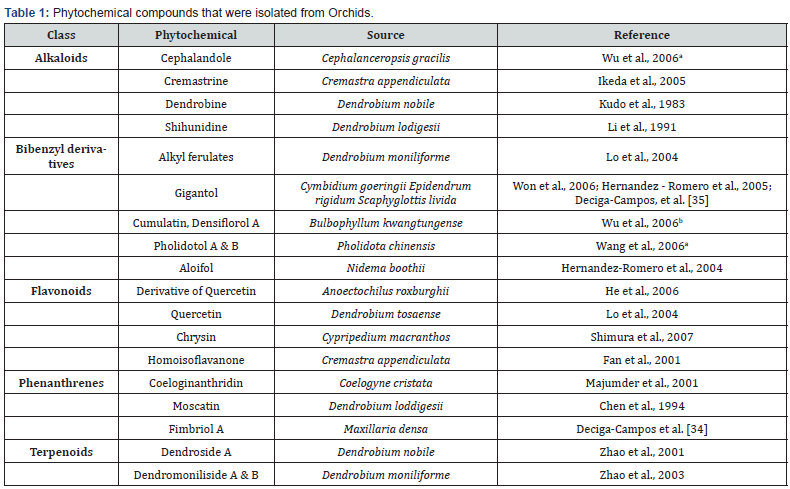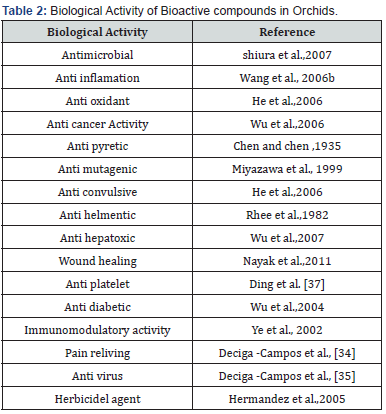Pharmacognostic Study, Traditional Medicinal Uses, And Pharmacological Activities of Crepidium Amplectens
Vijay Nigam*, Saurabh Dubey, Shivam Chaurasia, and Kanchan Agarwal
Daksh Institute of Pharmaceutical Science (DIPS), Chhatarpur, Madhya Pradesh, India
Submission: May 15, 2023; Published: May 26, 2023
*Corresponding author: Vijay Nigam, Daksh Institute of Pharmaceutical Science (DIPS), Chhatarpur, Madhya Pradesh, India, Email id: vijaynigam79@gmail.com
How to cite this article: Vijay N, Saurabh D, Shivam C, Kanchan A. Pharmacognostic Study, Traditional Medicinal Uses, And Pharmacological Activities of Crepidium Amplectens . Ann Rev Resear. 2023; 9(2): 555759. DOI: 10.19080/ARR.2023.09.555759
Abstract
Crepidium amplectens is one of nature’s most extravagant flowering plants i.e. It is grown primarily at a height of more than 1500fts in India and different parts of the world. It has been used in many parts of the world in traditional healing systems as well as in the treatment of a number of diseases since ancient times. It belongs to the largest family of plant kingdom i.e., Orchidaceae. Yet no studies have been done regarding its medicinal properties and traditional uses. Here brief research is carried out on its phytochemical profile and pharmacology to rule out its medicinal properties. Microscopy of leaf shows starch grains, stone cells, fibers, vessels are important anatomical characteristics of organized drugs. Plant shows aphrodisiac, haemostatic, anti-diarrheal, styptic, anti dysenteric, febrifuge, cooling and tonic. It faces the extreme danger of extinction due to over-exploitation and habitat loss.
Keywords: Medicinal Herbs; Styptic; Aphrodisiac; Haemostatic; Anti-Diarrheal; Anti Dysenteric; Febrifuge
Introduction
Ayurveda is eternal and its tradition is everlasting. It continues to flow from ancient times. The history of Ayurvedic literature being associated with Brahma and other devtas is very ancient, dignified and enormous. Dhanvantri the lord described that Ayurveda is the science of life. It is a mirror of life (beneficial, non-beneficial, happy and unhappy factors of life). The main purpose of Ayurveda is to protect the health of a healthy person and to mitigate the disorders of a patient. The recognition of Charaka, Susuruta and other Samhitas, in their own way, continues from ancient times. The principles of health protection described in Ayurveda, tools for disease free life, good conduct and noble behavior and other issues described lucidly are important in all their perspectives. The rhizomes are elongated (thus, the plants are well-spaced, e.g., C. distans (Schltr.) Szlach.) or abbreviated (plants clustered, e.g., C. resupinatum (G. Forst.) Szlach.) and are sometimes branched. Pseudobulbs are erect, elongate, fusiform, few are noded, usually completely covered by leaf bases and basal scales, and arise from the basal nodes of the previous pseudobulb, or from the tip of the rhizome. The leaves are usually 3–6 in number (rarely 2; rarely up to 10), spirally arranged, and clustered at the apical part of the shoot. The leaf-sheath and petiole are well-developed. The leaf-blade is always plicate and membranous; and often at least slightly oblique, ovate to lanceolate, or elliptic to oblong. The leaves of the plant are more or less attenuate, acute at the apex, basally cordate, rounded, or more rarely cuneate; and 1, 3, 5, or 7-veined. The flowers are small to medium-sized (mostly ca. 0.5 cm, occasionally up to 2.3 cm in diameter—e.g., C. megalanthum (Schltr.) Szlach.) [1-20].
Materials and Methods
Literature research is conducted using different available literature on the drug, such as classical text of Ayurveda and other compendium. Botanical & medicinal Data is also collected from various books, magazines, journals, periodicals and papers published in the e-journal etc. The review was conducted with an interactive strategy of combining the keywords Astavarga, Ayurveda, Jivaniya, Bramahniya, Nighantu, Samhita etc.
Study area
Considering the availability of the plant, the study is conducted in different areas of Uttarakhand, especially Dehradone. Mussoorie, popularly known as the “Queen of Hills” is a charming hill station situated at an altitude of 2003 mts (+6500 FT) above sea-level in the Garhwal hills of Uttarakhand.
Identification
The samples of plant materials were identified with the help of standard local flora. Preliminary identification was done by examining fresh plants procured by the local villagers. The corresponding raw materials were collected, and the morphological characters were compared with the fresh plants and vernacular names.
Geographical distribution
Species of Crepidium are found in tropical countries including China, the Indian subcontinent All around the world it is found in Pakistan, Bhutan, and Tibet between 1500-3100 mts elevation. In India found in Central and Eastern Himalaya from Uttarakhand to Assam and Sikkim up to an altitude of 3300 mts in alpine grassland, grassy hill sides, damp gullies and stony slopes.
Specific Habitat
Himachal Pradesh- Shimla, Glen fall, Baluganj, Elysium Hill, on the way to Rani Forest, on the way from Khajiyar to Chamba, Chail, Hattu peak and Narkanda. Uttarakhand-Dehradun-Camelback Road, on Mussoorie bypass road, above Barlowgunj in Chakrata, Jaunsar Tehri (Magra); Pauri-Pode khal; Chamoli-Nagnath, Ukhimath, Gopeshwar; Pithoragarh-Sarju Valley, Bernath, Thalkedar; Nainital-Bhawali, Ramgarh; Almora-Between Ranikhet and Chaubatiya (Figure 1).

Taxonomic Features
The stem is underground, spreading, fibrous roots downwards, ribbed. Leaves-Usually 2-4, sessile or petiolate, 6.5-11.5 cm long, ovate-lanceolate, often discolored, green, acute with prominent veins, leaves in whorls on the nodes directly raised upwards, angular, attenuate, stem covered with basal leaves forming a tubular structure. Flowers-scape-7.6 -21 cm long, flower small shortly stalked in terminal raceme, about 10 mm in diameter, yellowish green with purple centre. Bracts- spreading shorter than the ovary. Sepals-oblong, dorsal 1-4 nerved, lateral 3-5 nerved, 2 laterals rather shorter than the dorsal, margins recurved. Petalslinear, slender, longer than sepals, margin recurved, lip-6, shield like, slightly convex, tip rounded, notched or bilabiate, adnate to the base, the column sides of the lip produced upwards into large auricles, auricle of the lip very variable, acute, or obtuse, straight, and slightly overlapping. Staminal Column- Very short with short spreading arms. Anthers- Sub terminal, pollinia-4. Fruits-6 chambered capsule. Seeds- minute, powdery, ovoid, pseudobulbs 3-9 cm long and 1-3 cm in diameter, conical, fleshy, smooth, shining, in pairs, new one look like garlic cloves, greenish white, covered with membranous sheath, slightly mucilaginous, remain alive over longer period. Flowering: July-August. Fruiting: September-October [21-37].
Phytochemical Profile
Pseudobulbs contain alkaloid, glycoside, flavonoids and β-sitosterol. Also contains piperitone, O-Methylbatatasin-1, 8-cineole, citroenellal, eugenol, glucose, rhamnose, coline, limonene, p-cymene and ceryl alcohol (Table 1).

Pharmacological Activities
a) Pseudo bulbs are Sweet, aphrodisiac, haemostatic, antidiarrhoeal, styptic, antidysentric, febrifuge, cooling and tonic. It is useful in sterility, vitiated conditions of Pitta and Vata, semen related weakness, internal and external hemorrhages, dysentery, fever, emaciation, burning sensation and general debility.
b) Jivaniya (Vitality promoter)- This medicinal plant is vitality promoter, maintaining the balance between three doshas i.e., Vata, Pitta and Kapha. It enhances the energy, body strength, skin glow and other properties of the body.
c) Bramhaniya (Body mass promoter)- This medicinal plant is body mass promoter. It is described within the Bramhaniya varga.
d) Ayushya (Longevity)- This medicinal plant mitigate the disorder of the body and specifically alleviates Tridosaja disorder in the body to increase longevity and slow down the process of ageing.
e) Antioxidant activity: Pseudo bulb extract of Crepidium amplectens shows antioxidant activity.
f) Antifungal and Antibacterial Activity-Extract of Crepidium amplectensshows antifungal and antibacterial activites.
g) The ethanol extract of its pseudo bulb exhibits analgesic and anti-inflammatory activity in experimental animals.
Classical Medicinal Uses
a) Intake of Mahamayur Ghrita processed with Jivaka and other herbs is useful in Rasaraktadi dhatugat vikara, shrotadi indriya vikara (sensory organ disorders), svarabhransa (Aphesia), asthma, cough, facial paralysis, vaginal disorders, blood disorders and semen related problems.
b) Intake of powder prepared from Jivaka, and other herbs mixed with an appropriate quantity of honey and crystal sugar is useful in cough and cardiac diseases.
c) Vacadi Taila processed with Jivaka, and other herbs used as anuvasana vasti; is beneficial for Gulma, distention, Vata associated disorders and urinary incontinence.
d) Intake of Jivaniya Ghrita processed with Jivaka is useful for the whole body vitiated with gout and Vata associated disorders.
e) Citrakadi Taila processed with Jivaka, and other herbs is useful in Vata associated disorders, sciatica, limping, kyphosis, gout, and urinary disorders.
f) Mahapadma Taila processed with Jivaka, and other herbs is useful in gout and fever.
g) Jivaniya Ghrita processed with Jivaka and other herbs, used properly, can be effective in treating gout and other chronic Vata associated disorders.
h) Asthapana vasti processed with Jivaka and other medicinal herbs is useful in treating Gulma, metrorrhagia, anaemia, malaria.
i) Intake of Ghrita processed with Devadaru, Kakoli, Jivaka and other medicinal herbs given in proper dose is useful in child emaciation.
j) Himavana Agada prepared with the powder of Pancavalkala, Jivaka and other herbs mixed with honey to make a paste and external application of this paste on snake bite alleviates the toxicity. It also alleviates other symptoms like edema, erysipelas, boils, fever and burning sensation.
Traditional Medicinal Uses
a) Decoction prepared from its pseudo bulb is useful in general debility.
b) Intake of powder prepared from its pseudo bulb is useful in seminal weakness.
c) Intake of its pseudobulb powder promotes lactation
Discussion
Crepidium amplectens (Jeevak) plant found in Central and Eastern Himalaya from Uttarakhand to Assam, Sikkim and other neighboring states is of significant importance due to its multipurpose efficacy in the management of different disorders and maintenance of proper health. Crepidium amplectens is one among 292 species of genus Crepidium and family Orchidaceae. It can provide various miraculous remedies for several severe disorders. The environmental protection and conservation of Crepidium amplectens requires immediate attention. A detailed and serious survey of its natural habitat is also required to ensure its availability. Another research study is required to find out its ecological behavior in the natural environment - so as to increase its density. Research work must be initiated in this direction which is possible through tissue culture and modern agricultural practices.
Conclusion

The information collected regarding Crepidium amplectens needs a thorough phytochemical investigation including alkaloid extraction and isolation with some clinical trials, biological evaluation on experimental animal models, toxicity studies etc. People are cultivating Crepidium amplectens (Jeevak) for their economic upliftment and thereby protecting the species from danger of extinction. But there is an urgent need in addition to protection and conservation to create mass awareness among the local people regarding the promotion of its therapeutic efficacy. The paper highlights information to conserve Crepidium amplectens for sustainable medicinal uses for the future generation. Since Ayurveda and ethnobotany continue to play a major role in medical therapy, it is of utmost importance to conserve these resources for the welfare of mankind. This species has been listed as “Endangered” for the globe, however, based on its low density, frequency, and abundance in natural pockets in Himachal Pradesh, Jammu & Kashmir, and Uttarakhand, it deserves to be categorized as “Critically Endangered” for the globe; the natural habitats of these species throughout the Himalayas need to be identified and officially protected for conservation (Table 2).
References
- Acharya Balkrishna (2012) Secrets of Astavarga Plants (for vitality and anti-aging), Divya Prakashan, Patanjali Yogpeeth, Uttarakhand, Haridwar.
- Dey A C (1982) Indian medicinal plants used in Ayurvedic preparations, Bishan Singh Mahender Pal Singh, Dehradun.
- Duthie J F (1906) The Orchids of North-Western Himalaya, Ann Roy Bot Gard Calcutta 9: 81-211.
- Dwivedi Vishwanath (Commentator) (1977) Bhav Prakash Nighantu, Motilal Banarsi Das, Delhi.
- Gupta Atrideva (2002) Asthangha Samgraha, Krishana Das Academy Varanasi p. 2.
- Hooker JD (1997-1999) Flora of British India. Bishen Singh Mahendra Pal Singh 23-A, New Connaught place, Dehradun, 248001, India. (5-6) (reprints) models. J Ethnopharmacol 127(2): 521-527.
- Mathur DR (2003) Yogtarangini Varanasi (India): Chaukhamba Vidhya bhawan.
- Mishra Brhmashankar, Vaisya R (1984) BhavaPraksh of Shri Bhav Mishra, Chaukhamba Sanskrit Sansthan, Varanasi.
- Naithani BD (1985) Flora of Chamoli. Vol 2 Howrah, Botanical Survey of India, Department of Environment. Bishen Singh Mahendra Pal Singh, Dehra Dun pp. 196.
- Nayar A, CKN, Mohanan, N (1995) Medicinal Plants of India, Nag Publishers, Delhi-7.
- Osmaston AE (1978) A Forest Flora for Kumaon, Bishen Singh Mahendra Pal Singh, Dehradun, India.
- Pandey D (2005) Sarangadhara samhita, Varanasi (India), Chaukhamba Amarabharati Prakashan.
- Pandey Madan Mohan, Govinddarajan, R, Khatoon, Sayyada, Rawat, Ajay Kumar Singh, et al. (2006) Pharmacognostical studies of Polygonatum cirrhifolium and Polygonatum verticillatum. Journal of Herbs, Spices & Medicinal Plants 12(1-2): 37-48.
- Pandit, Ramprasad (1998) Madanpal Nighantu, Khemraj Shri Krishanadass, Mumbai.
- Parashar, Shri Radhakrishana (1974) Sharngadhar Samhita, Shri Vaidyanath Ayurved Bhavan Pvt Ltd Nagpur.
- Polanin O, Stainton, Adam (1984) Flowers of Himalaya, Oxford University Press, Delhi.
- Sharma Priyavrata (1987) Cikitsakalika, Chaukhamba Surbharti, Prakashan Varanasi, (First Edition).
- Sharma Pushpa, Mahajan, Nipun, Garg Pankaj, Singh Gurkirpal, Dadhwal Sumit, et al. (2011) Malaxis acuminata- A review, International Journal of Research in Ayurveda & Pharmacy 2(2): 422-425.
- Sharma RS (1969) Vanaushadhi Nidarshika, Kashi Hindu University, Varanasi.
- Sharma PV, Sharma Guru Prasad (1998) Dhanwantri Nighantu Chaukhamba Orientalia, Varanasi pp. 108.
- Singh, Thakur Balwant, Chunekar, KC (1972) Glossary of Vegetable Drugs in Brihattrayi, Chaukhamba Sanskrit Series office, Varanasi.
- Trikamji, Yadav ji (1971) Dravya Guna Vigyanam, Shri Sharma Ayurveda Mandir, Nagpur.
- Tripathi, Brahmanand (2003) Asthangha Hridyam, Chaukhamba Sanskrit Pratishthan, Delhi.
- Tripathi, Brahmanand (2004) Charaka-Samhita, Chaukhamba Surbharti Prakashan, Varanasi p. 1-2.
- Tripathi, Indra Deva (2006) Arkaprakasha, Chowkhamba Krishnadass Academy Varanasi, (Second Edition).
- Tripathi, Indra Deva. 2006. Raj Nighantu, Chowkhamba Krishanadass Academy, Varanasi.
- Tripathi JP (Commentator) (1983) Chakradatta of Shri Chakrapani Datta. Chaukhamba Sanskrit Series office, Varanasi.
- Tripathi, Ravi Dutt (2006) Astanga-Samgraha sutrasthana, Chaukhamba Sanskrit Pratishthan.
- Uniyal, Mayaram (1975) Astavarga Sandigdha Vanaushadhi, Dhanwantri Patrika, Shri Jwala Ayurved Bhavan Aligharh.
- Uniyal, Mayaram (1989) Medicinal Flora of Garhwal, Himalayas. Shree Baidyanath Ayurved Bhavan, Nagpur.
- Vaisya Shri Shaligram (2007) Shaligram Nighantu Bhushanam, Khemraj Shri Krishnadass, Mumbai p. 7-8.
- http://envis.frlht.org/plant_details.php?disp_id=1367&parname=7559
- Da Silva Jaime A Teixeira (2013) Orchids: Advances in tissue culture, Genetics, Phytochemistry and Transgenic Biotechnology. Floriculture and Ornamental Biotechnology 7(1): 1-52
- Déciga-Campos M, Palacios-Espinosa JF, Reyes-Ramírez A, Mata R, et al. (2007) Antinociceptive and anti-inflammatory effects of compounds isolated from Scaphyglottis livida and Maxillaria densa. J Ethnopharmacol 114(2): 161-168.
- Déciga-Campos M, Rivero-Cruz I, Arriaga-Alba M, Castañeda-Corral G, Angeles-López GE, et al. (2007b) Acute toxicity and mutagenic activity of Mexican plants used in traditional medicine. J Ethnopharmacol 110(2): 334-342.
- Dhyani A, Nautiyal BP, Nautiyal MC (2010) Importance of Astavarga plants in traditional systems of medicine in Garhwal, Indian Himalaya. Plant, Cell, Tissue, and organ Culture 101(2): 163-170.
- Ding CS, Shen YS, Li G, Wei Z, Wei F, et al. (2007) Study of a glycoprotein from Gastrodia elata: its effects of anticoagulation and antithrombosis. Zhongguo Zhong Yao Za Zhi 32(11): 1060-1064.






























